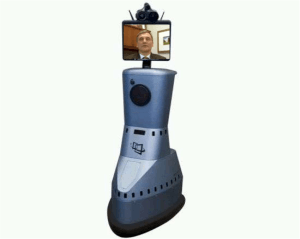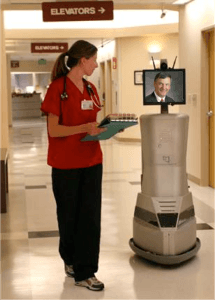Every few years, we see news articles about virtual reality robots that will roam hospital hallways – delivering medicines or supplies or allowing remote physicians to examine and communicate with patients in far-off locales who might not otherwise get to benefit from their specialized expertise (see this recent news story with video).
Less widely known is the experimentation with executive “Gemba Bots” that allow hospital CEOs and senior leaders to “roll the gemba.” This technology promises to let CEOs visit “the gemba” (where the work is done, in the Lean parlance) without leaving the comfort of their office or board room.
In this post, I reveal some of my exclusive research into this technology – the promise and the downsides….
Early Management Robots in the 1980s
While hospitals in the 1980s weren't practicing Lean management (and people weren't calling it Lean in the mid-1980s anyway), they did experiment with robotic enhancements to management methods of the day. As “management by wandering around” became fashionable, time-strapped executives looked for ways to automate this time-consuming practice. Enter – management by wheeling around.
Since MBWA was popularized by Hewlett-Packard, it was natural that they would borrow technology developed at Xerox Parc and partner with GM Fanuc Robotics Corporation (part of General Motors). They developed BlameBot, pictured at left.
BlameBot was a huge time saver, as it rolled randomly around the hospital greeting employees and saying things like “Be careful…. shame on you… we are going to hold you accountable” over and over.
A rare recording of a BlameBot in action was shared by the W. Edwards Deming Institute and the family of the late Dr. Deming. During a hospital stay, Dr. Deming encountered a prototype and was so disturbed that he asked his assistant to record some audio as she followed it down the hallway (audio used with permission, copyright 1988, W. Edwards Deming Institute).
Use the audio player below to listen to this exclusive audio:
Dr. Deming is reported to have muttered “robots painting robots” as he returned to his room.
Later versions of BlameBot included more advanced chitchat such as “how are the kids?”, “how about that local sports team?”, and “hot enough for you?” Staff satisfaction scores declined and BlameBot's use never extended beyond a few cutting-edge hospitals.
An Idea Revisited in the 2000s
Traditional managers always find robots and automation very appealing, so, not surprisingly, the idea was revisited during the dot com boom of the late 1990s. The dot com bust brought us failed companies such as:
- iCEO
- Managr
- Blahyoo (which famously spent $2 million in an ad in the 2000 Super Bowl, forgetting they had only raised $1 million in venture funding)
- BuddyBot (the latest version of BlameBot)
Some of the internet enable CEO robot technology was acquired by Intel, which continued the push into the hospital space.
This MSNBC article from 2004 described how “robotic doctors” would visit patients. I certainly remember these stories, but the media wrote less about the applications for robotic CEOs.
As I continued my research, I asked John Toussaint, MD, former CEO of ThedaCare, if he knew any hospital CEOS who had participated in these experiments. He was embarrassed to recall this, but he actually participated in some of this round of experimentation before he became a Lean thinker and a great Lean leader.
Toussaint recalls:
“I was just learning about Lean and my staff members were doing all of those Rapid Improvement Events. One of my mentors, George Koenigsaecker told me I needed to get to the gemba and see what was really happening. But I was a busy, all-knowing CEO… I didn't have time for that. So BuddyBot seemed like a great way for me to reduce wasted motion, saving time for the important CEO stuff.”
See the picture, at left, for a photo of these early trials, shared by the now-defunct ThedaCare Center for Advanced Management Robotics (copyright, 2003). As you can see, all that appeared was a static image of John, but he could see and talk with staff members.
Toussaint says the BuddyBot (with its built-in sensors) measured that it saved him 1400 miles of walking alone in that first year. “We would dress BuddyBot up in a Packers uniform in the fall… everyone thought it was quite a hoot.”
The 2004 model of BuddyBot brought a sleeker design and live video of John now appeared on screen, allowing him to interact more naturally with staff members it could actually chase down.

Instead of roaming on a pre-programmed track, John could now pilot BuddyBot from the comfort of a specially-constructed room adjacent to his office, as pictured at left.
Toussaint tells a story in his outstanding book On the Mend: Revolutionizing Healthcare to Save Lives and Transform the Industry, now a Shingo award winner (congrats!!), where a staff member challenged him on changing his own leadership approach to better model Lean behaviors. The little-known fact, now revealed here, is that the interaction was actually with John via BuddyBot… and that was the last time BuddyBot was used at ThedaCare.
Lean Trend in the 2010s: Actually Walking to the Gemba
To Toussaint's credit, he learned that, as the CEO, he had to change. He started participating in Rapid Improvement Events. ThedaCare sold BuddyBot to a Wisconsin General Motors plant and he started actually going to the gemba to see with his own eyes, not through a digital video camera.
As Toussaint later blogged:
Going to Gemba is not an action to be taken lightly. It's hard work and it takes time to learn how to do it effectively. It must be done often to be learned. I invite you to start going to Gemba once a week for four weeks. Each time you go write a log of what you have seen, then compare what you saw the first time to the fourth time. I think you will be surprised you have started to learn to see.
How do we get other healthcare senior leaders to get out of their offices and out to the gemba? Will people learn there is no substitute for actually walking (not rolling) to the gemba and seeing things with your own eyes (not via silicon image sensors)? Or will we be blogging in a few years about holographic gemba visits, ala Princess Leia in Star Wars?
Are you going to the gemba, regardless of your leadership level? Are your senior leaders doing this? Have you tried convincing them?
Past Lean Blog April Fools' Jokes (see them all)
- A New Way to Learn Lean? Wii Lean! (2010)
- New “A3” App Utilizes Two iPads & Virtual Sensei Technology (2011)
Please scroll down (or click) to post a comment. Connect with me on LinkedIn.
Let’s work together to build a culture of continuous improvement and psychological safety. If you're a leader looking to create lasting change—not just projects—I help organizations:
- Engage people at all levels in sustainable improvement
- Shift from fear of mistakes to learning from them
- Apply Lean thinking in practical, people-centered ways
Interested in coaching or a keynote talk? Let’s start a conversation.













Took me a few paragraphs! : )
Nice. Happy April Fools Day to you too, Mark.
[…] Graban at LeanBlog.org has a nifty reflection on the use of virtual reality technology in the field of healthcare as it pertains to management and application of lean […]
Hi Mark,
Nice take – truth maybe scarier than reality sometimes ;-)
Honda’s brilliant “Living with Robots” offers further thinking on why we may not be quite there on Gemba bots:
http://dreams.honda.com/#/video_wi
Stay safe,
Mike
Ahhhh.. the wonders of technology!
Mark, no one can accuse you of lack of imagination!
Nice new annual joke from MoreSteam, Inc.:
http://www.ississippi.org/Less-Than-Free-MBB.cfm
Less-Than-Free MBB(tm)
“”There’s a race to the bottom on MBB certification standards, and we’re not going to lose that race,” said Zoltan Minsky, President of ISSISSIPPI. “In fact, we’ve redefined where the bottom is by offering a product that is less than free! Five exam questions might seem like a lot, but we’ve lessened that burden by removing other so-called ‘requirements’ like project portfolio reviews and the knowledge of obscure subjects like statistical process control, hypothesis testing, and Design of Experiments. If professionals tell us that they have executed an impressive body of successful project work, who are we to doubt them?””
Y’all might be interested in my new book “Baby’s First Lean Book”:
http://babysfirstleanbook.com